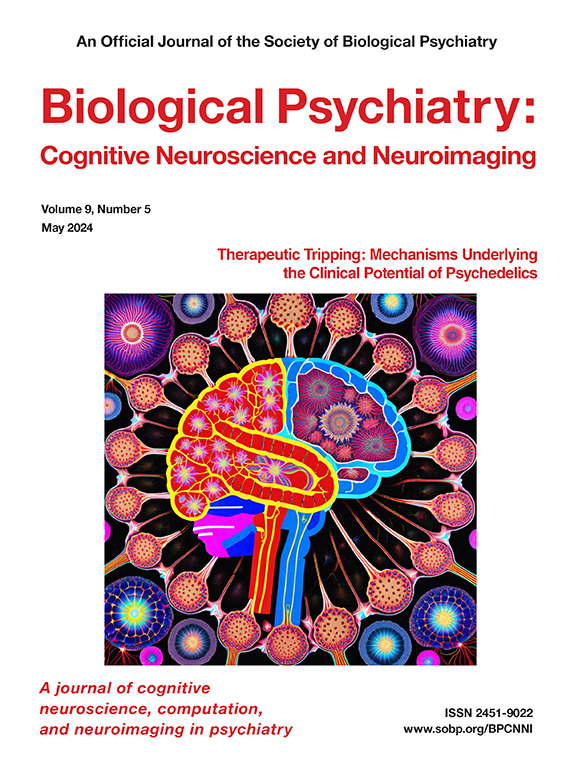Beyond the Descriptive: A Comprehensive, Multidomain Validation of Symptom Trajectories for Individuals at Clinical High Risk for Psychosis
IF 5.7
2区 医学
Q1 NEUROSCIENCES
Biological Psychiatry-Cognitive Neuroscience and Neuroimaging
Pub Date : 2025-02-01
DOI:10.1016/j.bpsc.2024.08.020
引用次数: 0
Abstract
Background
Although the clinical high risk for psychosis (CHR-P) criteria are widely used to ascertain individuals at heightened risk for imminent onset of psychosis, it remains controversial whether CHR-P status defines a diagnostic construct in its own right. In a previous study, CHR-P nonconverters were observed to follow 3 distinct trajectories in symptoms and functioning: remission, partial remission, and maintenance of symptoms and functional impairments at subthreshold levels of intensity.
Methods
Here, we utilized the NAPLS3 (North American Prodrome Longitudinal Study phase 3) sample (N = 806) to determine whether 1) the same trajectory groups can be detected when assessing symptoms at 2-month intervals over an 8-month period and 2) the resulting trajectory groups differ from each other and from healthy control participants and converting CHR-P cases in terms of risk factors, comorbidities, and functional outcomes.
Results
Three distinctive subgroups within the CHR nonconverters were identified, largely paralleling those observed previously. Importantly, these extracted groups, together with non-CHR control participants and CHR converters, differed from each other significantly on putative etiological risk factors (e.g., predicted risk scores, physiological and self-report measures of stress), affective comorbidities, and functional outcomes, thus providing converging evidence supporting the validity of the identified trajectory groups.
Conclusions
This pattern, together with the fact that even the subgroup of CHR-P nonconverters who showed a remission trajectory deviated from healthy control participants, supports treating the CHR-P syndrome not only as a status that denotes risk for onset of full psychosis but also as a marker of ongoing distress for a population that is in need of interventions.
超越描述:针对精神病临床高危人群的症状轨迹的综合、多领域验证。
背景:尽管临床精神病高危人群(CHR-P)标准被广泛用于确定即将罹患精神病的高危人群,但CHR-P状态本身是否可定义为一种诊断结构仍存在争议。在之前的一项研究中,CHR-P 非转换者在症状和功能方面被观察到遵循三种不同的轨迹:缓解、部分缓解以及症状和功能障碍维持在阈值以下的强度水平。方法:在此,我们利用北美前驱症纵向研究第三阶段(NAPLS3)样本(N = 806)来确定:1)是否存在相同的轨迹分组?1)在 8 个月的时间内,每隔 2 个月对症状进行评估时,是否能检测出相同的轨迹组;2)由此得出的轨迹组在风险因素、合并症和功能结果方面是否彼此不同,是否与健康对照组和转换为 CHR-P 病例的对照组不同:结果:在未转换 CHR 的病例中发现了三个不同的亚组,与之前观察到的亚组基本一致。重要的是,这些被提取出来的群体与非 CHR 对照组和 CHR 转换者在推定的病因风险因素(如预测风险评分、生理和自我报告压力测量)、情感合并症以及功能结果方面存在显著差异,为所识别的轨迹群体的有效性提供了一致的证据:这种模式,以及即使是显示出缓解轨迹的CHR-P非转换者亚组也偏离健康对照组这一事实,都支持将CHR-P综合征不仅作为一种表示全面精神病发病风险的状态,而且作为需要干预的人群的持续困扰的标志。
本文章由计算机程序翻译,如有差异,请以英文原文为准。
求助全文
约1分钟内获得全文
求助全文
来源期刊

Biological Psychiatry-Cognitive Neuroscience and Neuroimaging
Neuroscience-Biological Psychiatry
CiteScore
10.40
自引率
1.70%
发文量
247
审稿时长
30 days
期刊介绍:
Biological Psychiatry: Cognitive Neuroscience and Neuroimaging is an official journal of the Society for Biological Psychiatry, whose purpose is to promote excellence in scientific research and education in fields that investigate the nature, causes, mechanisms, and treatments of disorders of thought, emotion, or behavior. In accord with this mission, this peer-reviewed, rapid-publication, international journal focuses on studies using the tools and constructs of cognitive neuroscience, including the full range of non-invasive neuroimaging and human extra- and intracranial physiological recording methodologies. It publishes both basic and clinical studies, including those that incorporate genetic data, pharmacological challenges, and computational modeling approaches. The journal publishes novel results of original research which represent an important new lead or significant impact on the field. Reviews and commentaries that focus on topics of current research and interest are also encouraged.
 求助内容:
求助内容: 应助结果提醒方式:
应助结果提醒方式:


